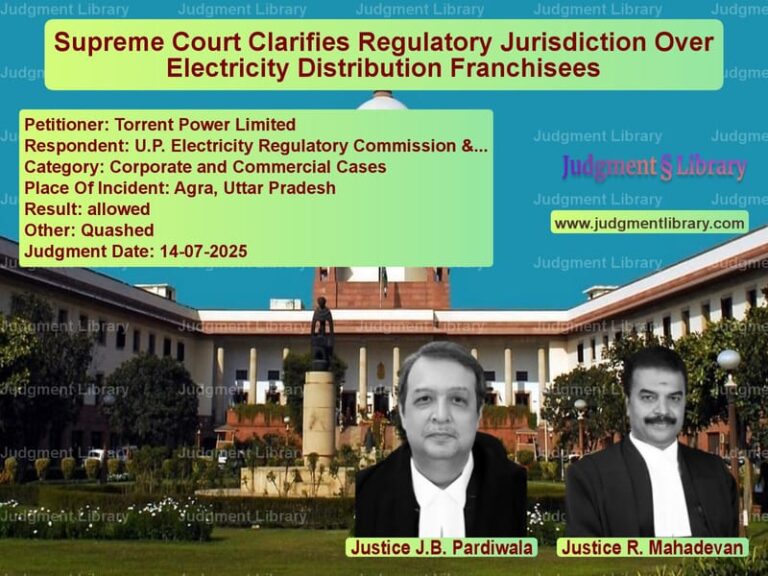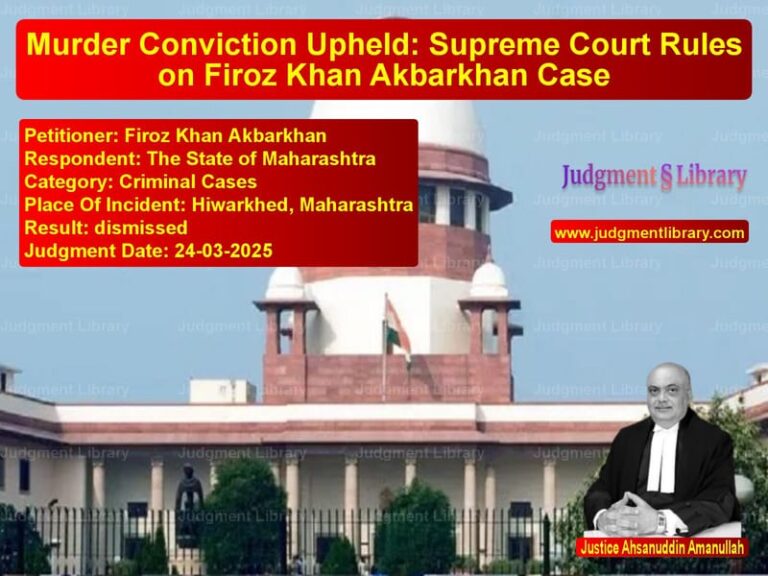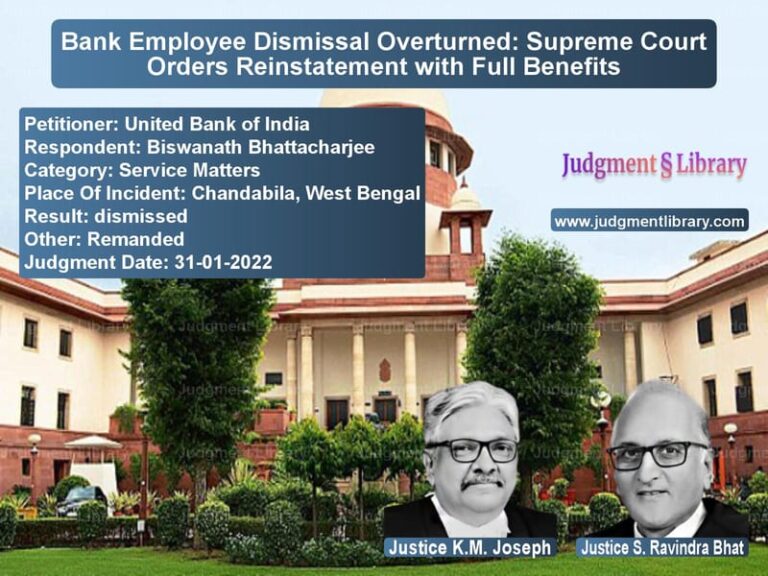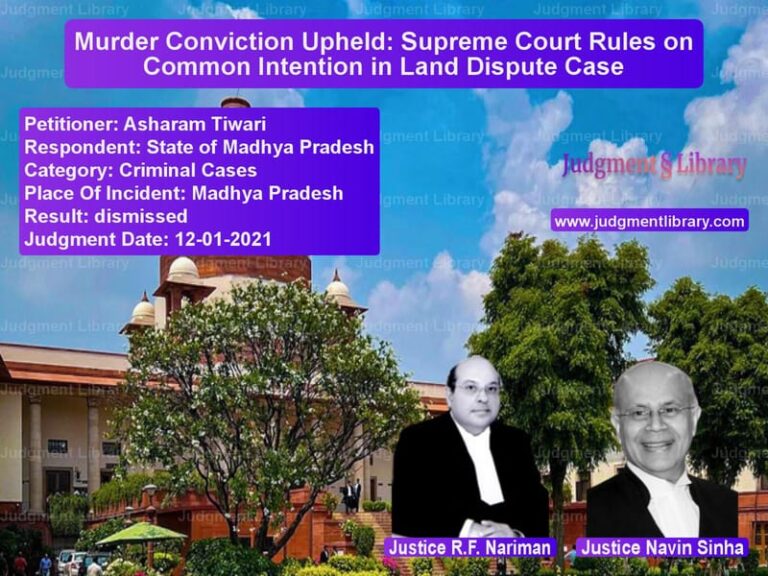Land Dispute Over Boundary Wall: Supreme Court Reverses Kerala High Court Decision
The case of Raghavan Sasikumar vs. Parameswaran Nadar Sathyananadhan Nadar Kanakottu Padippura Veedu and Others revolved around a land boundary dispute that had been litigated for decades. The dispute concerned the extent of property ownership and whether the plaintiffs could construct a boundary wall beyond the area recognized in previous judgments.
Background of the Case
The dispute arose from the ownership and possession of land originally belonging to one Parameswaran Nadar. The plaintiffs, who were his wife and children, sought to construct a boundary wall to demarcate their land. However, the defendants, who claimed kudikidappu rights (protected tenant rights), contested the claim, arguing that they had acquired title through adverse possession.
The litigation had a long history, beginning with O.S. No. 833 of 1961, in which the original landowner’s title was upheld for an area of 2 acres and 35 cents. Further cases such as O.S. No. 640 of 1970 had also ruled on aspects of possession and kudikidappu rights.
In 1988, the plaintiffs filed a fresh suit, O.S. No. 665 of 1988, seeking to construct a boundary wall for B Schedule items 1 and 2, arguing that the defendants had exceeded their entitlement under the kudikidappu provisions.
Lower Court Findings
The trial court dismissed the suit, finding that the defendants had been in possession of more than 10 cents and that their claim of adverse possession had merit. This decision was upheld by the first appellate court.
The plaintiffs then approached the Kerala High Court through Second Appeal No. 39 of 2000. The High Court set aside the decisions of both lower courts and ruled in favor of the plaintiffs, permitting them to construct the boundary wall as per the commissioner’s report.
Supreme Court Appeal
The defendants, dissatisfied with the High Court’s ruling, challenged the decision before the Supreme Court. The appeal primarily questioned whether the plaintiffs could construct a boundary wall beyond the 2 acres and 35 cents granted in the 1961 case.
Arguments Presented
Petitioners’ (Defendants) Arguments
- The defendants contended that the High Court had erred in overturning the concurrent findings of the trial and appellate courts.
- They argued that the plaintiffs could not claim land beyond what was awarded in the 1961 judgment.
- The High Court had wrongly ruled that the defendants were entitled to only 10 cents as kudikidappukars, a finding that went beyond the scope of the suit.
Respondents’ (Plaintiffs) Arguments
- The plaintiffs argued that they had clear title to the land and were entitled to secure their property by constructing a boundary wall.
- They relied on the commissioner’s report, which suggested that they were in possession of 2 acres and 77 cents, to claim a larger area than previously recognized.
- They contended that the defendants had no valid legal claim to the excess land.
Supreme Court’s Analysis and Judgment
The Supreme Court reviewed the entire case history and found that the High Court had misinterpreted the law. It noted that the 1961 judgment had conclusively established that the plaintiffs’ title was limited to 2 acres and 35 cents. Therefore, the plaintiffs could not claim a larger area, and the High Court’s ruling allowing them to construct a boundary wall beyond this limit was incorrect.
Key Observations by the Supreme Court
- The Court reiterated that any possession beyond 2 acres and 35 cents by the plaintiffs was unauthorized.
- It held that “If the plaintiffs are permitted to put up the boundary wall beyond 2 acres and 35 cents, in that case, it would be contrary to the earlier judgment and decree passed in O.S. No. 833 of 1961.”
- The Court found that the High Court had overstepped its jurisdiction by making findings about the defendants’ entitlement under kudikidappu rights.
Final Judgment
- The Supreme Court allowed the appeal, setting aside the High Court’s ruling.
- The judgments of the trial court and the first appellate court were restored, thereby dismissing the plaintiffs’ suit.
- The Court ruled that the plaintiffs could only construct a boundary wall within the 2 acres and 35 cents awarded in the 1961 judgment.
Implications of the Judgment
This ruling has significant implications for property disputes:
- It reinforces the principle that previous judgments regarding land ownership are binding and cannot be re-litigated.
- It limits the High Court’s power to overturn concurrent factual findings of lower courts without strong legal grounds.
- It clarifies that parties cannot use possession as a basis to claim ownership beyond the recognized legal title.
Conclusion
The Supreme Court’s ruling in this case serves as a crucial precedent in property law, particularly in cases involving long-standing land disputes. It upholds the sanctity of prior judgments and ensures that legal boundaries are respected. The judgment reinforces that judicial intervention must align with established legal principles and prior rulings, preventing unjust expansion of land claims based on possession alone.
Petitioner Name: Raghavan Sasikumar.Respondent Name: Parameswaran Nadar Sathyananadhan Nadar Kanakottu Padippura Veedu and Others.Judgment By: Justice M.R. Shah, Justice B.V. Nagarathna.Place Of Incident: Kerala.Judgment Date: 01-08-2022.
Don’t miss out on the full details! Download the complete judgment in PDF format below and gain valuable insights instantly!
Download Judgment: raghavan-sasikumar-vs-parameswaran-nadar-s-supreme-court-of-india-judgment-dated-01-08-2022.pdf
Directly Download Judgment: Directly download this Judgment
See all petitions in Property Disputes
See all petitions in Landlord-Tenant Disputes
See all petitions in Specific Performance
See all petitions in Judgment by Mukeshkumar Rasikbhai Shah
See all petitions in Judgment by B.V. Nagarathna
See all petitions in allowed
See all petitions in Quashed
See all petitions in supreme court of India judgments August 2022
See all petitions in 2022 judgments
See all posts in Civil Cases Category
See all allowed petitions in Civil Cases Category
See all Dismissed petitions in Civil Cases Category
See all partially allowed petitions in Civil Cases Category







